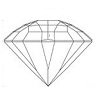16.23: Benitoite
- Page ID
- 4359
| Benitoite | |
|---|---|
| Chemical composition | BaTiSi3O9 |
| Crystal system | Trigonal |
| Habit | Bipyramids |
| Cleavage | None |
| Fracture | Conchoidal |
| Hardness | 6.5 |
| Optic nature | Uniaxial + |
| Refractive index | 1.75-1.80 |
| Birefringence | 0.047 |
| Dispersion | High, 0.046 |
| Specific gravity | 3.65 |
| Lustre | Bright vitreous |
| Pleochroism | Strong |
Benitoite is a very rare mineral that was discovered in 1907 in San Benito County in California. It has never been found elsewhere. It was originally mistaken for sapphire. Benitoite is very highly dispersive (the ability to take white light and disperse it into various components of the spectrum) with an adamantine luster when polished.
Benitoite is associated with other rare minerals such as black-red neptunite, snow white natrolite, and brown-yellow joaquinite. Since the only source of this rare combination occurs at San Benito County, California, it has been designated the California state gemstone. Crystals, and cut stones tend to be small and quite expensive!

Figure \(\PageIndex{1}\): Photo Courtesy of Rob Lavinsky
Figure \(\PageIndex{2}\): Photo Courtesy of Barbra Voltaire
Spectrum

Figure \(\PageIndex{3}\): 4mm faceted benitoites, Colorless to Dark Blue
Photo Courtesy of Barbra Voltaire

Figure \(\PageIndex{4}\): Transmission Spectrum
The more saturated the blue, the higher the peak in the 400-500 nm range
Cause of Color
The origin of color in benitoite has not been definitively established.
Proposed ideas include:
Fe2+ - Ti4+ or the Fe2+ - Fe3+ intervalance charge transfer.
While most benitoite is colorless when viewed down the c-axis, there is a very small number (3) of exceedingly rare stones (now cut into gemstones) which are pink in this direction.
The Benitoite Gem Mine
The Early Days: An Interview with Ed Swoboda and Peter Bancroft
G&G Articles on Benitoite 1934-1980
The GIA has published all the G&G's from 1934 until 1980 online. The organization of the list by subject was done by Joseph Gill.
- Summer 1953, Benitoite, by Ehrmann, p. 317, 1p.
- Summer 1963, A beautiful 4 1/2-ct. benitoite and a colorless benitoite, p. 55, 1p.
- Spring 1968, Pink benitoite from Calif., p. 284, 2pp.
- Spring 1968, Benitoite Inclusions, p. 285, 2pp.
Additional Information
Dr. Edward Gübelin Collection: Benitoite



